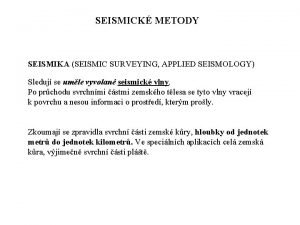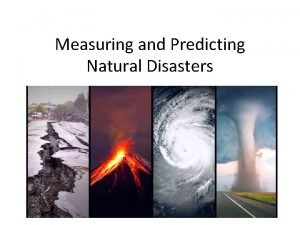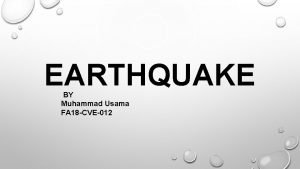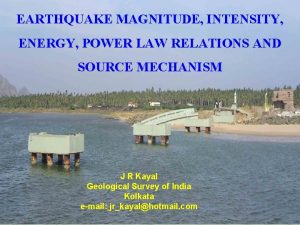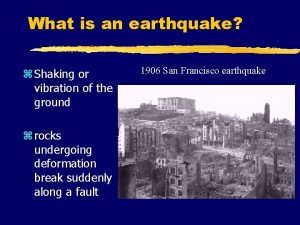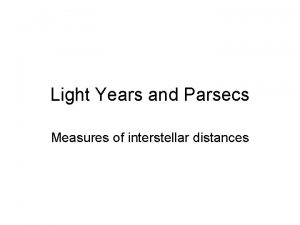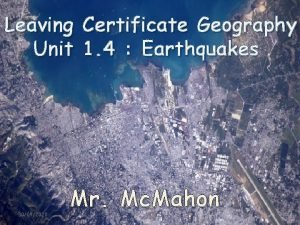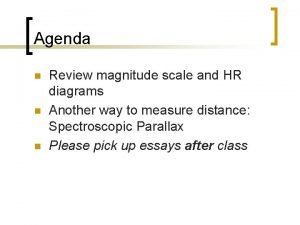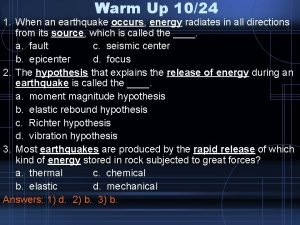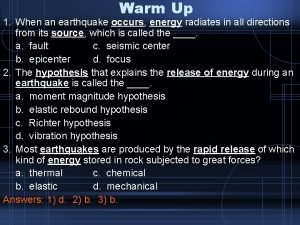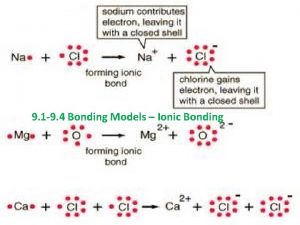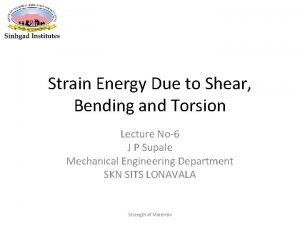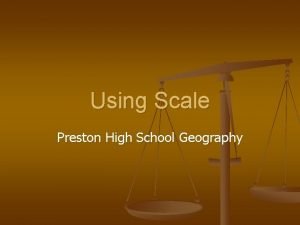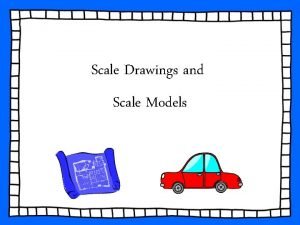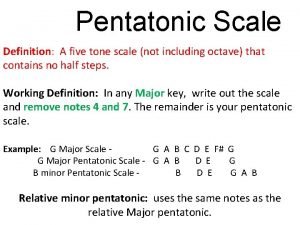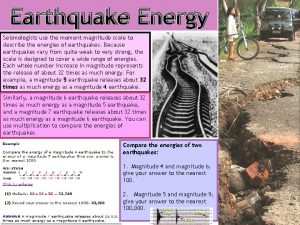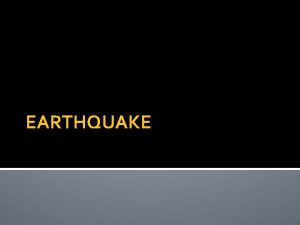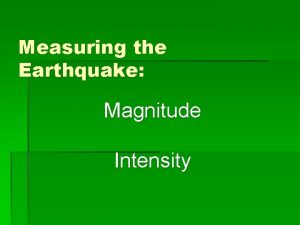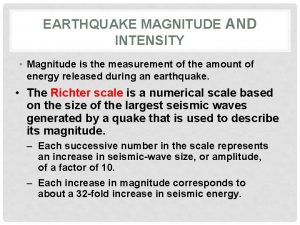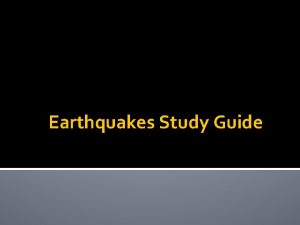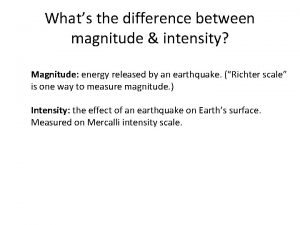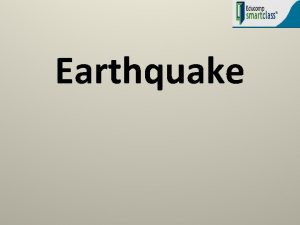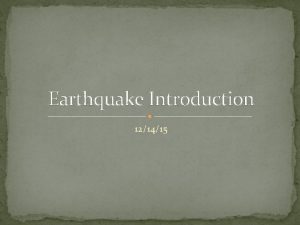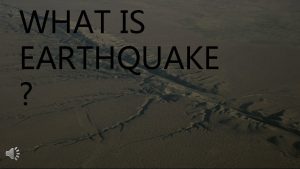Earthquake Energy Seismologists use the moment magnitude scale


















- Slides: 18

Earthquake Energy Seismologists use the moment magnitude scale to describe the energies of earthquakes. Because earthquakes vary from quite weak to very strong, the scale is designed to cover a wide range of energies. Each whole number increase in magnitude represents the release of about 32 times as much energy. For example, a magnitude 5 earthquake releases about 32 times as much energy as a magnitude 4 earthquake. Similarly, a magnitude 6 earthquake releases about 32 times as much energy as a magnitude 5 earthquake, and a magnitude 7 earthquake releases about 32 times as much energy as a magnitude 6 earthquake. You can use multiplication to compare the energies of earthquakes. Compare the energies of two earthquakes: 1. Magnitude 4 and magnitude 6; give your answer to the nearest 100. 2. Magnitude 5 and magnitude 9; give your answer to the nearest 100, 000.

Earthquake damage can be reduced. (Page 60) BEFORE, you learned • Seismic waves travel through Earth • An earthquake's location and magnitude can be determined NOW, you will learn • How an earthquake's magnitude is related to the damage it causes • How structures are built to withstand most earthquakes • How scientists estimate the earthquake risk in an area Magnet Word Diagram= Include: definition, example(s), picture, pronounce, origin, sentence. -aftershock -liquefaction - tsunami

Earthquakes can cause severe damage and loss of life. Every year, on average, an extremely powerful earthquake—one with a magnitude of 8 or higher—strikes somewhere on Earth. Such an earthquake can destroy almost all the buildings near its epicenter and cause great loss of life. Earthquakes are most dangerous when they occur near areas where many people live. Most injuries and deaths due to earthquakes are not directly caused by the movement of the ground. They are caused by collapsing buildings and other structures and by fires. After an earthquake, fires may start due to broken natural-gas lines, broken electrical power lines, or overturned stoves.

Earthquake Magnitude A very powerful earthquake can release more energy than 1 million weak earthquakes combined. Earthquake magnitude scales give scientists and engineers a simple way to describe this huge range in energy. The first scale of earthquake magnitude was developed in California during the 1930 s by the scientists Charles Richter (RIHK-tuhr) and Beno Gutenberg. In this scale, called the Richter scale, an earthquake's magnitude is based on how fast the ground moves at a seismic station. However, most scientists today prefer to use a newer, more accurate scale: the moment magnitude scale. This scale is based on the total amounts of energy released by earthquakes. The moment magnitude scale is used for all earthquake magnitudes given in this chapter. Both the Richter scale and the moment magnitude scale are often shown with a top value of 10, but neither actually has a maximum value. On each scale, an increase of one whole number indicates an increase of 32 times more energy. For example, a magnitude 5 earthquake releases 32 times as much energy as a magnitude 4 earthquake and about 1000 times as much energy as a magnitude 3 earthquake.


The moment magnitude scale is more accurate for larger earthquakes than the Richter scale. Another advantage of the moment magnitude scale is that it can be used for earthquakes that occurred before seismographs were invented. Geologists can measure the strength of the rocks and the length they moved along a fault to calculate a past earthquake's magnitude. This information is important for geologists to know when they determine an area's earthquake risk. What are two advantages of the moment magnitude scale over the Richter scale? Damage from Earthquakes Movement of the blocks of rock on either side of a fault can crack roads, buildings, dams, and any other structures on the fault. As blocks of rock move, they can also raise, lower, or tilt the ground surface. Sometimes structures weakened by an earthquake collapse during shaking caused by aftershocks. An aftershock is a smaller earthquake that follows a more powerful earthquake in the same area. Also, fires that break out can cause great damage if broken water pipes keep firefighters from getting water. In the 1906 San Francisco earthquake, fires caused more than 90 percent of the building damage.

Earthquakes can cause major damage by affecting the soil and other loose materials. For example, landslides often occur as a result of earthquakes. A landslide is a movement of soil and rocks down a hill or mountain. Earthquakes can cause soil liquefaction, a process in which shaking of the ground causes soil to act like a liquid. For a short time the soil becomes like a thick soup. Liquefaction occurs only in areas where the soil is made up of loose sand silt and contains a large amount of water. As the shaking temporarily changes the wet soil, structures either sink down into the soil or flow away with it. Shaking of the ground also affects areas that have mixtures of soils. Some soil types pack together more than others when shaken. List five ways in which earthquakes can cause damage.

Damage from Tsunamis If you sit on an ocean beach, you can watch the depth of the water change as waves come in. If you watch for a longer time, you may notice bigger changes as the tide rises or falls. A special type of wave, however, can make water rise more than the height of a 20 -story building. This wave, known as a tsunami (tsu-NAH-mee), is a water wave triggered by an earthquake, volcanic eruption, or landslide. Tsunamis are sometimes called tidal waves, but they are not caused by the forces that produce tides. A tsunami may not be a single wave but several waves that can have different heights and can arrive hours apart. Tsunamis move quickly and can travel thousands of kilometers without weakening. In deep water, they can reach speeds of about 700 kilometers per hour (430 mi/h). A tsunami in the deep water of the open ocean may be less than one meter (3 ft) in height at the surface. As a tsunami reaches shallow water around an island or continent, however, it slows down, and its height greatly increases. Miyako, Japan tsunami wave; Indian Ocean; Japan 2011 (last 2)

A 1946 earthquake on Alaska's coast caused a tsunami that swept across the entire Pacific Ocean. In Alaska the tsunami destroyed a new U. S. Coast Guard lighthouse that otherwise would have been able to send warnings to other areas. In less than five hours, the tsunami reached Hawaii as a series of waves. The highest wave was about 17 meters (55 ft) tall. Because people did not know of the danger, no one had evacuated, and 159 people were killed. Many earthquakes occur around the edges of the Pacific Ocean. Therefore, Hawaii and other areas in and around this ocean are likely to be hit by tsunamis. The Pacific Tsunami Warning Center, located in Hawaii, was established in 1949. The center monitors earthquakes and issues warnings to areas that could be struck by tsunamis.


Scientists work to monitor and predict earthquakes. Scientists cannot yet predict the day or even the year when an earthquake will occur. Sometimes there are signs years before an earthquake strikes, and sometimes there are none at all. Usually the best that scientists can do is to give longterm predictions. For example, they might state that an area has a 60 percent chance of being hit by an earthquake with a magnitude 7 or higher within the next 25 years. The map on the left shows earthquake risks in the United States for the next 50 years. The map is based on information about earthquakes that have occurred since people began keeping records, along with evidence of earlier earthquakes preserved in rocks. Note that most areas with the highest earthquake risks are near the Pacific Ocean.

To learn more about earthquakes and to find ways of predicting them, scientists all over the world study seismic activity along faults. They monitor whether stress is building up in the rocks along faults. Such signs include • tilts or changes in the elevation of the ground • slow movements or stretching in rock • the development of small cracks in the ground An increase in small earthquakes can be a sign that stress is building up along a fault and that a large earthquake is likely to occur. But an increase in small earthquakes can also be a sign that a fault is releasing stress bit by bit, decreasing the likelihood of a major earthquake. Scientists also look for areas where earthquakes have not occurred along an otherwise active fault. They make diagrams in which they plot the locations where earthquakes have started, as shown to the right. Sometimes such a diagram shows an area of few or no earthquakes that is surrounded by many earthquakes. This area is called a seismic gap. A seismic gap can indicate a location where a fault is stuck. Movement along other parts of the fault can increase stress along the stuck part. This stress could be released by a major earthquake. Why can a lack of earthquakes in an area near an active fault cause concern?


Structures can be designed to resist earthquake damage. For safety, it might be best to be outdoors, far from any buildings, during an earthquake. But there is no way to tell just when or where an earthquake will occur. For this reason, the best way to reduce deaths, injuries, and damage from earthquakes is to build structures able to withstand strong ground shaking. The first step is to understand what the risks from earthquakes are in an area. The second step is to build structures that are appropriate for the area. Scientists make maps of areas to show the locations of fault zones, past earthquakes, and areas likely to experience flooding, landslides, or liquefaction. In Japan, California, and other areas that have many earthquakes, planners use these maps to develop rules for building new structures and strengthening older ones. The maps are also used to select building locations that are stable— unlikely to experience landslides or liquefaction. Here, the term structure refers to office buildings, homes, bridges, dams, factories —all the things that people build.

Earthquake damage to small buildings, such as most houses, often occurs when the buildings are shaken off their foundations. Small buildings are better protected when they are firmly fastened to their foundations. Also, their walls need to be strong. Some houses were built before modern safety rules were in place. The walls of these houses can be made stronger by adding supports. Supports are particularly important in brick walls, which can easily collapse in an earthquake. A special type of steel is commonly used for the supports because it is strong and is able to bend, then return to its original shape.


Many of the methods used to make larger buildings and other structures safer are designed to reduce the amount they shake during an earthquake. One method is to use devices called base isolators, as shown in the illustration. Base isolators are placed between a building and its foundation. The isolators are made of flexible materials that are stacked in layers like pancakes. When an earthquake occurs, the isolators absorb much of the ground motion. Any shaking that does reach the building is slower and smoother. A building may also have an open space, or moat, around it. The moat, which may be covered at the surface with sidewalks and landscaping, lets the building shake more gently than the ground during an earthquake. Special walls, called shear walls, add strength to a structure. These walls contain steel supports. Shear walls in the center of a building are often built around a stairwell or an elevator shaft. These walls make up a part of the building known as the shear core. Walls can also be made stronger by adding braces. Pairs of braces that form an X shape are called cross braces. They help a structure keep its shape while it is being shaken. Describe two methods used to make buildings stronger.

Reducing Earthquake Damage Review Questions (Page 67) KEY CONCEPTS 1. How is an earthquake magnitude scale related to the amounts of energy released by earthquakes? 2. What are the major dangers to people from an earthquake? 3. Name three methods of improving a building's safety before an earthquake. CRITICAL THINKING 4. Apply What might people living next to the ocean do to protect themselves if they were given a two-hour warning of an approaching tsunami? 5. Connect If you lived in an area where earthquakes were common, what could you do to make your room safer? CHALLENGE 6. Analyze Earthquakes release stress that has built up in rocks. Why do you think aftershocks occur?
 Seismologists definition
Seismologists definition Moment magnitude scale vs richter
Moment magnitude scale vs richter Earthquake scale
Earthquake scale What is the richter scale
What is the richter scale Earthquake magnitude classification
Earthquake magnitude classification San francisco earthquake 1906 magnitude
San francisco earthquake 1906 magnitude Parsecs to light-years
Parsecs to light-years Causes of earthquake in points
Causes of earthquake in points Magnitude scale stars
Magnitude scale stars When an earthquake occurs energy radiates
When an earthquake occurs energy radiates When an earthquake occurs energy radiates
When an earthquake occurs energy radiates Lattice energy trends
Lattice energy trends Magnitude of lattice energy
Magnitude of lattice energy Energy energy transfer and general energy analysis
Energy energy transfer and general energy analysis Energy energy transfer and general energy analysis
Energy energy transfer and general energy analysis Shear strain energy formula
Shear strain energy formula Small vs large scale maps
Small vs large scale maps 7-7 scale drawings and models practice
7-7 scale drawings and models practice Five
Five
